HVACrefinerguy
Harmless

Posts: 5
Registered: 16-12-2017
Member Is Offline
Mood: No Mood
|
|
Neon yellow precipitate from electrical contacts
Hey guys so I'm new here and I've never had good looks with forums maybe I just don't understand how to do searches or how they actually work but
anyway I've processed electrical contacts many times in the past without incident this time I processed electrical contacts in nitric acid as usual
but there is some sort of yellow neon green precipitate that had formed in the nitric acid I've never come across this before this is probably my 10
or 15th time recovering silver from electrical contacts also when I cemented the silver out of the contacts it appears there is some other sort of
metal in there that is cementing out possibly Pd or Hg. I've included pictures of both any help would be greatly appreciated. Just an FYI I did a DMG
test and it came up negative for palladium maybe I have bad DMG but the sponge definitely does not look like any sort of silver sponge I've ever
encountered
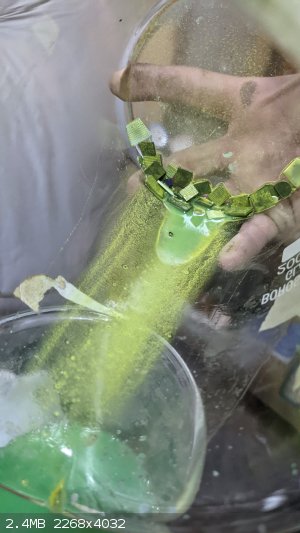 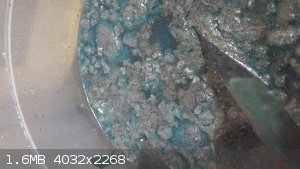 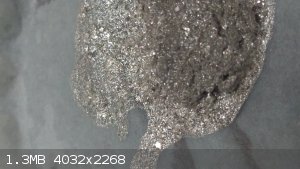
|
|
|
Fluorite
Hazard to Others
  
Posts: 132
Registered: 26-12-2018
Location: United Arab Emirates
Member Is Offline
|
|
Cadmium sulfide? A yellow precipitate formed when hydrogen sulfide is passed though an acidified solutions.
Cadmium salts can be recognized by the brown incrustation which is formed when they are heated on charcoal in the oxidizing flame of the blowpipe
but I'm not sure nitric acid can oxidize sulfides to sulfates
Try adding hydrochloric acid to this and see if it dissolves but be careful cadmium is contact poison! Wear gloves and work outside and DON'T BREATHE
THE MIST\SPRAY;
[Edited on 21-11-2020 by Fluorite]
|
|
|
unionised
International Hazard
    
Posts: 5102
Registered: 1-11-2003
Location: UK
Member Is Offline
Mood: No Mood
|
|
Is there any chloride present?
CuCl will form if there's excess copper. It is white,but gets "stained" by other materials in solution.
You should be able to collect some and wash it with clean water by decantation.
It's soluble in ammonia or dilute nitric acid.
The solution in ammonia is theoretically colourless but usually some oxidises and it is pale blue.
Exposure to air or the addition of peroxide rapidly converts it to the deep blue/ purple copper(II) ammonia complex.
|
|
|
HVACrefinerguy
Harmless

Posts: 5
Registered: 16-12-2017
Member Is Offline
Mood: No Mood
|
|
Thanks fluorite I will try this I was thinking it was maybe W or Cd. one question though how could it be cadmium sulfate when only nitric acid was
used to dissolve these electric contacts
|
|
|
HVACrefinerguy
Harmless

Posts: 5
Registered: 16-12-2017
Member Is Offline
Mood: No Mood
|
|
Quote: Originally posted by unionised  | Is there any chloride present?
CuCl will form if there's excess copper. It is white,but gets "stained" by other materials in solution.
You should be able to collect some and wash it with clean water by decantation.
It's soluble in ammonia or dilute nitric acid.
The solution in ammonia is theoretically colourless but usually some oxidises and it is pale blue.
Exposure to air or the addition of peroxide rapidly converts it to the deep blue/ purple copper(II) ammonia complex.
|
No there are no chlorides present this is what was left in the bottom of the beaker dissolving the electrical contacts in only nitric acid I have
refined electrical contacts many times and I'm usually left with the base but never this neon green before my procedure has not changed the only thing
that changed was this precipitate
|
|
|
HVACrefinerguy
Harmless

Posts: 5
Registered: 16-12-2017
Member Is Offline
Mood: No Mood
|
|
Quote: Originally posted by Fluorite  | Cadmium sulfide? A yellow precipitate formed when hydrogen sulfide is passed though an acidified solutions.
Cadmium salts can be recognized by the brown incrustation which is formed when they are heated on charcoal in the oxidizing flame of the blowpipe
but I'm not sure nitric acid can oxidize sulfides to sulfates
Try adding hydrochloric acid to this and see if it dissolves but be careful cadmium is contact poison! Wear gloves and work outside and DON'T BREATHE
THE MIST\SPRAY;
[Edited on 21-11-2020 by Fluorite] |
So I added some 32% hydrochloric acid to the contacts and the solution has turned yellow as well as there is now some dark blue coming from some of
the contacts.
Any ideas or is there a procedure that I can use to try to determine what this substance is
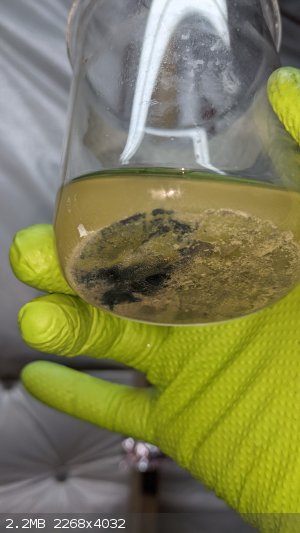
|
|
|
vmelkon
National Hazard
   
Posts: 669
Registered: 25-11-2011
Location: Canada
Member Is Offline
Mood: autoerotic asphyxiation
|
|
Can you collect some in a very tiny metal spoon or glass spoon. Heat it in a flame and see if you can melt it. What is the approximate mp? Does any
color change occur?
Signature ==== Is this my youtube page? https://www.youtube.com/watch?v=tA5PYtul5aU
We must attach the electrodes of knowledge to the nipples of ignorance and give a few good jolts.
Yes my evolutionary friends. We are all homos here. |
|
|
violet sin
International Hazard
    
Posts: 1475
Registered: 2-9-2012
Location: Daydreaming of uraninite...
Member Is Offline
Mood: Good
|
|
I was following this thread a couple days ago but only passing interest really. Since then I have chipped the contacts out of 2 large double
breaker's been sitting around for ages. Eight pads all in all about the size of a shirt button. They're not weighted or anything, just piled up
waiting for some action when a guy gets a break. Though I did start looking for information on the possible content of the assumed silver contacts.
This page has some information on different materials and why, which I thought was at least a little bit enlightening...
http://www.contactechnologies.com/Contact-Technologies-Mater...
"Silver tungsten is by far the most popular of the contact material families used in circuit breakers and other power switching devices".
Though they present a number of options, one stands out. You already assume W possibly and I think it's inline with the info they present. Would W
be oxidized into solution as hydrogen peroxide does to it? I've two flasks of the latter from dissolving halogen work light filaments, and the color
is similar to what your seeing. I'm not sure what would have cemented out with the silver though, not much time looking into this yet. Take a look
at the link to see if any of their combos present themselves as possibilities for your observations. You may have just picked up a couple that have a
new dopant/alloy content. Hope it helps.
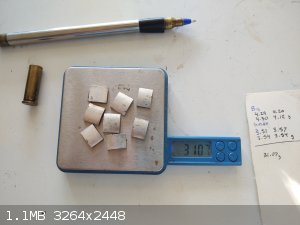 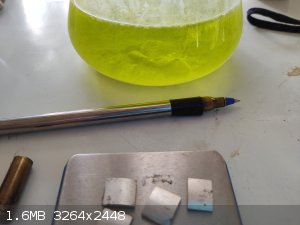
Included a pic of the dissolved W sol. (Not at all related to contacts mind you) I imagine the yellow ppt would be more compact from an oxidizing acid
solution than from a long term low % peroxide sol. situation I've let marinate for better part of a year, maybe two... Who knows I blink and it's
another season it seems these days.
|
|
|